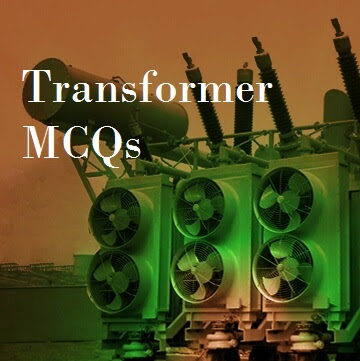TOP Electrical Transformers MCQ
Electrical Engineering MCQ 41TO 60
Multiple Choice Questions and Answers
Latest Transformers Interview Questions and Answers List
41. The use of higher flux density in the transformer design
(a) reduces weight per kVA
(6) reduces iron losses
(c) reduces copper losses
(d) increases part load efficiency
Ans: a
(a) reduces weight per kVA
(6) reduces iron losses
(c) reduces copper losses
(d) increases part load efficiency
Ans: a
42. The chemical used in breather for transformer should have the quality of
(a) ionizing air
(b) absorbing moisture
(c) cleansing the transformer oil
(d) cooling the transformer oil.
Ans: b
(a) ionizing air
(b) absorbing moisture
(c) cleansing the transformer oil
(d) cooling the transformer oil.
Ans: b
43. The chemical used in breather is
(a) asbestos fiber
(b) silica sand
(c) sodium chloride
(d) silica gel
Ans: d
(a) asbestos fiber
(b) silica sand
(c) sodium chloride
(d) silica gel
Ans: d
44. An ideal transformer has infinite values of primary and secondary inductances. The statement is
(a) true
(b) false
Ans: b
(a) true
(b) false
Ans: b
45. The transformer ratings are usually expressed in terms of
(a) volts
(b) amperes
(c) kW
(d) kVA
Ans: d
(a) volts
(b) amperes
(c) kW
(d) kVA
Ans: d
46. The noise resulting from vibrations of laminations set by magnetic forces, is termed as
(a) magnetostrication
(b) boo
(c) hum
(d) zoom
Ans: c
(a) magnetostrication
(b) boo
(c) hum
(d) zoom
Ans: c
47. Hysteresis loss in a transformer varies as CBmax = maximum flux density)
(a) Bmax
(b) Bmax1-6
(C) Bmax1-83
(d) B max
Ans: b
(a) Bmax
(b) Bmax1-6
(C) Bmax1-83
(d) B max
Ans: b
48. Material used for construction of transformer core is usually
(a) wood
(b) copper
(c) aluminium
(d) silicon steel
Ans: d
(a) wood
(b) copper
(c) aluminium
(d) silicon steel
Ans: d
49. The thickness of laminations used in a transformer is usually
(a) 0.4 mm to 0.5 mm
(b) 4 mm to 5 mm
(c) 14 mm to 15 mm
(d) 25 mm to 40 mm
Ans: a
(a) 0.4 mm to 0.5 mm
(b) 4 mm to 5 mm
(c) 14 mm to 15 mm
(d) 25 mm to 40 mm
Ans: a
50. The function of conservator in a transformer is
(a) to project against'internal fault
(b) to reduce copper as well as core losses
(c) to cool the transformer oil
(d) to take care of the expansion and contraction of transformer oil due to variation of temperature of sur-roundings
Ans: d
(a) to project against'internal fault
(b) to reduce copper as well as core losses
(c) to cool the transformer oil
(d) to take care of the expansion and contraction of transformer oil due to variation of temperature of sur-roundings
Ans: d
51. The highest voltage for transmitting electrical power in India is
(a) 33 kV.
(6) 66 kV
(c) 132 kV
(d) 400 kV
Ans: d
(a) 33 kV.
(6) 66 kV
(c) 132 kV
(d) 400 kV
Ans: d
52. In a transformer the resistance between its primary and secondary is
(a) zero
(b) 1 ohm
(c) 1000 ohms
(d) infinite
Ans: d
(a) zero
(b) 1 ohm
(c) 1000 ohms
(d) infinite
Ans: d
53. A transformer oil must be free from
(a) sludge
(b) odour
(c) gases
(d) moisture
Ans: d
(a) sludge
(b) odour
(c) gases
(d) moisture
Ans: d
54. A Buchholz relay can be installed on
(a) auto-transformers
(b) air-cooled transformers
(c) welding transformers
(d) oil cooled transformers
Ans: d
(a) auto-transformers
(b) air-cooled transformers
(c) welding transformers
(d) oil cooled transformers
Ans: d
55. Gas is usually not liberated due to dissociation of transformer oil unless the oil temperature exceeds
(a) 50°C
(b) 80°C
(c) 100°C
(d) 150°C
Ans: d
(a) 50°C
(b) 80°C
(c) 100°C
(d) 150°C
Ans: d
56. The main reason for generation of harmonics in a transformer could be
(a) fluctuating load
(b) poor insulation
(c) mechanical vibrations
(d) saturation of core
Ans: d
(a) fluctuating load
(b) poor insulation
(c) mechanical vibrations
(d) saturation of core
Ans: d
57. Distribution transformers are generally designed for maximum efficiency around
(a) 90% load
(b) zero load
(c) 25% load
(d) 50% load
Ans: d
(a) 90% load
(b) zero load
(c) 25% load
(d) 50% load
Ans: d
58. Which of the following property is not necessarily desirable in the material for transformer core ?
(a) Mechanical strength
(6) Low hysteresis loss
(c) High thermal conductivity
(d) High permeability
Ans: c
(a) Mechanical strength
(6) Low hysteresis loss
(c) High thermal conductivity
(d) High permeability
Ans: c
59. Star/star transformers work satisfactorily when
(a) load is unbalanced only
(b) load is balanced only
(c) on balanced as well as unbalanced loads
(d) none of the above
Ans: b
(a) load is unbalanced only
(b) load is balanced only
(c) on balanced as well as unbalanced loads
(d) none of the above
Ans: b
60. Delta/star transformer works satisfactorily when
(a) load is balanced only
(b) load is unbalanced only
(c) on balanced as well as unbalanced loads
(d) none of the above
Ans: c
(a) load is balanced only
(b) load is unbalanced only
(c) on balanced as well as unbalanced loads
(d) none of the above
Ans: c
Here You Can Also Read In Detail About


















